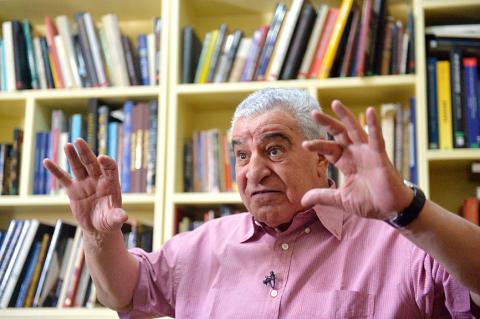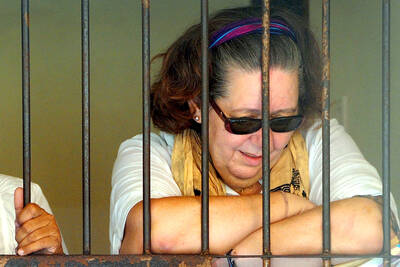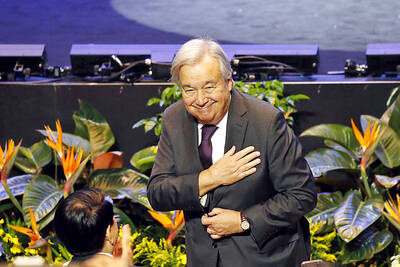From the Giza Pyramids to the pharaonic tombs of Luxor, Egypt’s ancient monuments are holding on to mysteries which researchers aim to unravel with cutting-edge technology.
For more than 200 years since Napoleon Bonaparte landed in Egypt with a retinue of scholars who laid the groundwork for modern Egyptology, experts have used science to unlock the secrets of the country’s ancient treasures.
In the 21st century, the scientists have been using electronic devices and chemical testing to date artefacts.

Photo: AFP
Chemical testing still requires small samples, but advanced techniques coming into use are meant to be non-invasive so as not to damage the ancient relics.
ScanPyramids is among the most ambitious of the projects to demystify the Khufu Pyramid near Cairo, the only surviving monument from the ancient Seven Wonders of the World.
It has employed infrared thermography and muography — a technique that records images using muon particles — in its quest.
The project had announced in October last year that the massive pyramid might contain undiscovered recesses.
“All the devices we put in place are designed to find where the cavity is located. We know there is one, but we’re trying to find out where,” said Mehdi Tayoubi, president of the HIP Institute heading the ScanPyramids project.
The muon devices include chemical emulsion instruments from Japan’s University of Nagoya, electronic sensors from the KEK Japanese Research Laboratory and muon telescopes from the French Atomic Energy Commission. The results are compared with infrared and 3D images.
Some archeologists have pinned hopes on the sophisticated technology to locate the burial place of the legendary queen Nefertiti.
The wife of King Akhenaten, who initiated a monotheistic cult in ancient Egypt, Nefertiti remains an enigma, best known for a bust depicting her that is on exhibition in Berlin’s Neues Museum.
British Egyptologist Nicholas Reeves believed her remains were hidden in a secret chamber in the tomb of Tutankhamun, in the southern Valley of the Kings.
In 2015, archeologists scanned the tomb with radar hoping for clues. Both Reeves’ theory and the inconclusive results have been dismissed by other Egyptologists.
One of them, former Egyptian minister of state for antiquities Zahi Hawass, said that an adept of the sun god Aton would never have been allowed to be buried in the Valley of the Kings.
The excitement over the possible discovery has died down since the inconclusive results, but a team from Politecnico University in Turin, Italy, intends to give it another shot.
This time they are to employ tomography — a method used in medical scans — and magnetometry, which measures magnetic fields.
Neither the Politecnico team nor the Egyptian Ministry of State for Antiquities has been inclined to discuss the fresh attempt, possibly put off by the anticlimactic media frenzy over the previous bid.
Elsewhere, Egyptologists are undertaking a project to nail down the chronology of Egypt’s ancient dynasties more precisely.
The French Institute of Eastern Archaeology (IFAO) in Cairo has a dating laboratory that the researchers are putting to use for the project.
“The chronology of ancient Egypt is not clearly defined. We use a relative chronology,” IFAO head of research Anita Quiles said.
“We refer to reigns and dynasties, but we do not know exactly the dates,” she said.
The investigation, which involves chemical testing, is expected to take several years.
However, Egyptologists say that science cannot replace archeologists and their work on the ground.
“It is important to have science in archeology, but it is very important not to let scientists announce any details about what they found unless it has been seen by Egyptologists,” Hawass said.

Indonesia was to sign an agreement to repatriate two British nationals, including a grandmother languishing on death row for drug-related crimes, an Indonesian government source said yesterday. “The practical arrangement will be signed today. The transfer will be done immediately after the technical side of the transfer is agreed,” the source said, identifying Lindsay Sandiford and 35-year-old Shahab Shahabadi as the people being transferred. Sandiford, a grandmother, was sentenced to death on the island of Bali in 2013 after she was convicted of trafficking drugs. Customs officers found cocaine worth an estimated US$2.14 million hidden in a false bottom in Sandiford’s suitcase when

CAUSE UNKNOWN: Weather and runway conditions were suitable for flight operations at the time of the accident, and no distress signal was sent, authorities said A cargo aircraft skidded off the runway into the sea at Hong Kong International Airport early yesterday, killing two ground crew in a patrol car, in one of the worst accidents in the airport’s 27-year history. The incident occurred at about 3:50am, when the plane is suspected to have lost control upon landing, veering off the runway and crashing through a fence, the Airport Authority Hong Kong said. The jet hit a security patrol car on the perimeter road outside the runway zone, which then fell into the water, it said in a statement. The four crew members on the plane, which

POWER ABUSE WORRY: Some people warned that the broad language of the treaty could lead to overreach by authorities and enable the repression of government critics Countries signed their first UN treaty targeting cybercrime in Hanoi yesterday, despite opposition from an unlikely band of tech companies and rights groups warning of expanded state surveillance. The new global legal framework aims to bolster international cooperation to fight digital crimes, from child pornography to transnational cyberscams and money laundering. More than 60 countries signed the declaration, which means it would go into force once ratified by those states. UN Secretary-General Antonio Guterres described the signing as an “important milestone,” and that it was “only the beginning.” “Every day, sophisticated scams destroy families, steal migrants and drain billions of dollars from our economy...

‘MOTHER’ OF THAILAND: In her glamorous heyday in the 1960s, former Thai queen Sirikit mingled with US presidents and superstars such as Elvis Presley The year-long funeral ceremony of former Thai queen Sirikit started yesterday, with grieving royalists set to salute the procession bringing her body to lie in state at Bangkok’s Grand Palace. Members of the royal family are venerated in Thailand, treated by many as semi-divine figures, and lavished with glowing media coverage and gold-adorned portraits hanging in public spaces and private homes nationwide. Sirikit, the mother of Thai King Vajiralongkorn and widow of the nation’s longest-reigning monarch, died late on Friday at the age of 93. Black-and-white tributes to the royal matriarch are being beamed onto towering digital advertizing billboards, on